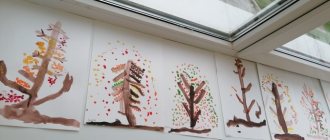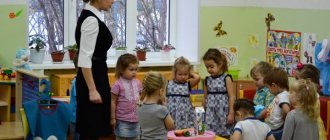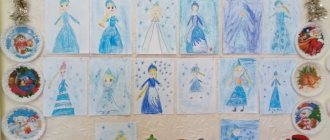Summary of GCD in the junior group on familiarization with the environment. Topic: “New Year at the Gate”
Summary of GCD in the junior group on familiarization with the environment.
Topic: “New Year at the Gate”
Integration of educational areas: “Cognition”, “Communication”, “Artistic creativity”.
Types of children's activities: educational and research,
communicative, gaming, musical and artistic, productive.
Target:
clarify and enrich children’s ideas about the upcoming event - the New Year holiday.
Tasks:
learn to look at objects (Christmas tree, Christmas tree decorations) and answer questions while looking at them;
Develop attention, speech, fine and gross motor skills, perception, creativity, independence;
Activate the dictionary on the topic “New Year’s holiday”;
Induce a joyful mood;
Cultivate friendly relations with each other.
Materials and equipment:
artificial Christmas tree (no more than 90 cm in height), a box with Christmas tree decorations made of safe material, a large sheet of Whatman paper with a pasted silhouette of a Christmas tree made of green paper (a painted Christmas tree), paper napkins of different colors; small silhouette Christmas trees cut out of white thick paper according to the number of children, colored pencils, easel.
Preliminary work:
watching the Christmas tree while walking, looking at paintings, illustrations on this topic, reading poetry, guessing riddles on this topic.
Progress:
1 part. Organizing time.
The teacher draws the children’s attention to the arriving guests and offers to greet them.
Surprise moment. There is a knock on the door. The teacher offers to see who knocked on the door. Having gone out the door, he returns with a Christmas tree and a box of New Year's toys, saying that Santa Claus passed by the kindergarten and left gifts for the children.
The teacher draws the children's attention to a small artificial Christmas tree and a box of Christmas tree toys.
Part 2. Clarification of the purpose of objects.
Questions:
- What is this? (Christmas tree, toys).
- What are toys for? (To decorate the Christmas tree).
— What holiday will be in kindergarten soon? (New Year).
Educator: For the holiday we will decorate the Christmas tree with Christmas tree toys (Takes out and shows toys from the box). And at the very top of the tree there will be a bright, beautiful star (Shows the star).
-What will we do at the holiday? (Sing songs, dance, dance around the Christmas tree).
- Who will come to our holiday? (Santa Claus, Snow Maiden, dads, moms).
-What are we going to tell them? (Poetry).
— What will Santa Claus bring in his big bag? (Present).
Part 3. Round dance around the Christmas tree (“Christmas tree”, music by E. Telicheeva, lyrics by M. Bulatov).
The teacher places the Christmas tree on the floor or on a low round table in the middle of the group and invites the children to dance around the Christmas tree.
Abstract of educational activities on cognitive development on the topic: “Excursion to the theater” in the 2nd junior group.
Author: Babenko Galina Pavlovna
Teacher of MKDOU Latnensky kindergarten “Rodnichok”
Abstract of educational activities on cognitive development on the topic: “Excursion to the theater” in the 2nd junior group.
Abstract of educational activities on cognitive development on the topic: “Excursion to the theater” in the 2nd junior group.
Priority educational areas:
cognitive development, speech development, social and communicative development, artistic and aesthetic development, physical development.
Target:
give children an initial understanding of the theater, its diversity and purpose.
Tasks:
Educational:
- to form children’s understanding of theater as a form of art, its diversity and purpose;
- introduce children to the professions of people working in the theater (artist, director, costume designer, set designer, musician) and the theater premises (auditorium, stage);
- to form children’s knowledge about the profession of an actor;
- consolidate knowledge about color and geometric shapes.
Educational:
- instill in children a love of theater;
- to form an emotional attitude towards literary works;
- introduce to verbal art through poetic rhymes;
- introduce the rules of behavior in the theater.
Educational:
- develop interest in theatrical and play activities;
- develop the ability to listen carefully to the teacher’s story and answer questions;
- develop the ability to listen to musical works (fragments) and relate them to literary images;
- to activate the speech activity of children, to enrich the active vocabulary on the lexical topic “Theater”;
- develop the ability to coordinate the actions of your character with the music, convey the image in motion using facial expressions, gestures, and plasticity;
- develop emotional responsiveness to music of a different nature;
- ensure optimal motor activity in the process of educational activities.
Preliminary work:
conversations: “What is theater?”, “Why do people go to the theater?”, “Who works in the theater?”, “How to behave in the theater?”, “What did I like about the theater?”; looking at pictures, illustrations on the topic, reading poems, watching a presentation about the theater.
Materials and equipment:
laptop, tape recorder, masks, theater chest, multi-colored models of geometric shapes, models - pictures “Rules of conduct in the theater”, plot pictures about the theater, sign “Theater box office”, poster, tickets, easel.
Progress of the lesson.
Educator:
Theater is a magical land!
How many miracles she gives us,
Holiday, smiles, songs and laughter
This country awaits us all!!!
Guys, have you been to the theater? (Children's answers).
What is theater?
(Teacher's story).
The theater is an amazing house where they show performances, fairy tales, where they dance and sing, and recite poems.
Educator:
Why do you guys think people go to the theater?
(Children's answers).
Adults and children go to the theater to watch a play, a fairy tale, listen to music, learn new things, and relax.
Every visit to the theater is a holiday. Let's go to the theater too. I will be your tour guide. I invite you to the easel. (Children sit near the easel on which the theater poster is placed).
Educator:
Look guys, what is this?
Bright, colorful! (Points to the poster attached to the easel).
This is a poster.
What does the poster say? Let's look at what's written on it. (Children look at the poster).
Tell me, guys, what is the name of the performance that is depicted on the poster?
(Children: “Kolobok”).
Who plays the roles?
(Children's answers).
That's right, the roles in the play are performed by actors who play a bun, grandmother, grandfather, bunny, wolf, bear, fox.
And who helps the artists? This is the director. He invites actors to play the roles of fairy-tale characters, shows the artists how to behave in order to be like their hero, and what voice to use. The director conducts rehearsals with the actors. What else can you learn from the poster? This is the date and time when the performance will take place. This is how much information we learned about the upcoming performance. And the poster helped us find out all this. What does every viewer need to have to get to the theater? Ticket. Where can I buy a ticket? At the register. This box office is called the theater box office. (Draws the children’s attention to the sign: “Theater box office”).
Educator:
Guys, stand in a circle and get your tickets.
(Hands out tickets to children).
A bell invites us into the auditorium.
(Rings the bell).
We won’t push each other, we’ll go in calmly,
And we’ll find our place with a ticket.
(Children look for their seats by the color and shape of geometric shapes: circle, square, rectangle and take them.
The color and shape of the geometric shape on the ticket must match the color and shape of the geometric shape on the back of the chair).
Educator:
Guys, show me your ticket, I'll check if you found your seat correctly.
(Children show their tickets to the teacher, he checks them).
Educator:
Do you want to be a good spectator?
(Children's answers).
Then let's get acquainted with the rules of behavior in the theater.
(He attaches pictures of “Rules of Conduct in the Theater” to the model’s easel and talks about each one in turn).
Educator:
What does this picture mean? The main rule is to maintain silence during the performance. It’s very important, guys, not to talk during the performance. What does this picture say? An important rule is to arrive on time. And this picture says that the actors need to clap when the performance is over.
Once the performance is over -
You can hear “Bravo!”, compliments;
To all the actors, in gratitude,
We give applause.
Educator:
Guys!
Show how you will clap. (Children clap their hands).
Educator:
And now I will tell you about what is in the theater.
(Display of the presentation “Theater”).
There is a wide screen in the cinema,
In the circus there is a manege or an arena.
Well, in the theater, an ordinary theater,
The platform is special - the stage.
Educator:
What is the stage like in the theater? Big, beautiful, wide. The largest theater room is the auditorium. Guys, look at the screen, what hall is it? Big, huge, beautiful, bright. Why is there so much in the auditorium? There are a lot of chairs and armchairs. How is the stage decorated? Decorated with a curtain - special curtains that are closed before the start of the performance. When the performance begins, darkness will fall in the auditorium, and the stage will be illuminated by multi-colored spotlights and spotlights.
Educator:
To make the show more interesting,
Applause was heard in gratitude,
The stage design needed is:
House, trees and other decorations.
Educator:
In order for the performance to be bright and colorful, scenery is needed.
They help the audience, us girls and boys, to find ourselves in a fairy tale near a beautiful castle, or in a dense forest near a hut on chicken legs. (Children look at images with different decorations).
Didactic game “Name the profession.”
Educator:
Guys, now we will all play a game together and name the professions of those who work in the theater.
(Based on the plot pictures, the children, together with the teacher, name the main professions: artist, director, costume designer, painter, musician).
Didactic game "Theater chest".
(Animal masks for children).
Educator:
Guys, do you want to turn into real artists?
(Children's answers).
There are different masks in my magic chest.
Choose and dress up. (Children choose masks of their choice and put them on).
Oh, my guys are unrecognizable!
Educator:
Polina, who do you want to turn into?
(Into the bunny).
What kind of hare, tell me, guys?
(Cowardly, fast).
Educator:
And who are you?
(The teacher asks all the children in turn, the children answer).
What kind of bear?
(Slow, heavy, big, bold).
What wolf?
(Hungry, gray, angry).
What kind of fox?
(Cunning, red-haired, beautiful).
Kolobok, ruddy side - which one?
(Cheerful, round, kind).
What kind of grandmother?
(Kind, caring).
Educator:
And now, we will all show together how real actors play their role.
(Music plays for each character, the character moves and dances according to his role).
Educator:
Well done boys!
Everyone did their part! You were real artists, and artists always bow after a performance. Let us also bow to each other. (Children bow).
Educator:
Now, let's all clap for each other.
(Children clap their hands).
Educator:
Guys, is it easy to be an artist?
How do you think? (Children's answers).
Not easy. Every day there is rehearsal. You must be able to laugh cheerfully, cry bitterly, dance well, sing and learn a lot of words by heart.
Didactic game “Show the mood.”
Educator:
Let's, guys, like real artists, we will also show a cheerful and joyful mood: let's smile at each other.
(Children exchange smiles).
Educator:
So you and I went to the theater and became artists. We learned so many new and interesting things about the theater.
We are very sorry to leave the theater.
We were artists so skillfully
What a pity that time flew by so quickly.
After all, everyone is happy to be an artist,
And for us, friends, it’s time to go to kindergarten!
Abstract of educational activities on cognitive development on the topic: “Excursion to the theater” in the 2nd junior group.




